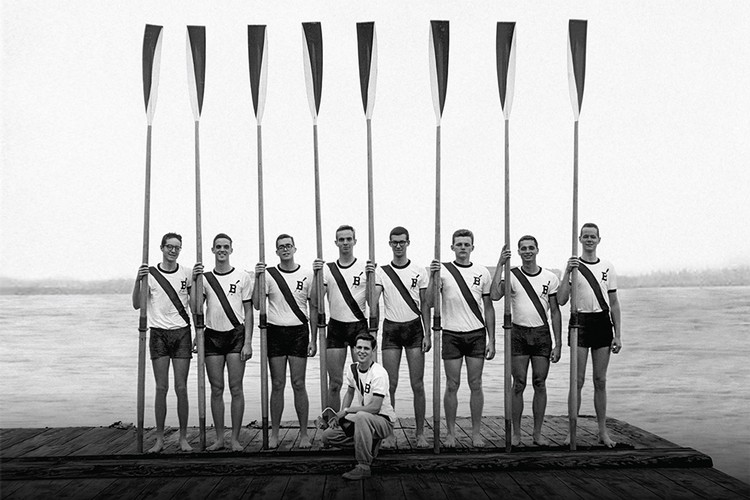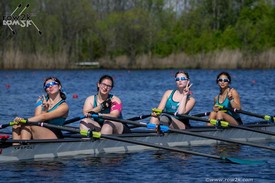
First, after the Civil War, Brown University rowed six-oared shells. But Brown discontinued the sport in 1875, according to the Brown Sports Hall of Fame citations for Harlan A. Bartlett '51 and Jim Donaldson '50.
Bartlett rowed at Phillips Academy Exeter. The two of them drove to Saint Andrews Prep in Delaware where Donaldson had rowed. There they picked up a 30-year-old shell, 65-foot-long, and tied it to the top of a 17-foot-long Oldsmobile.
So yawing, trembling shell carriers are very much a part of the elder history of Brown Crew. During the 17-hour return to Providence, they stopped at Princeton, where Coach Dutch Schoch, a member of The Boys in the Boat 1936 Berlin Gold Medal crew, gave them ten old oars. Where did they put them? Out the windows? Those 12-foot oars must have looked like the torpedoes on the bow of The African Queen.
The Hall of Fame citations also stress a 4-length victory over Clark University. Four lengths of course is a euphemism for a hundred lengths or more as we found out when we raced Clark on Lake Quinsigamond in Worcester. Sigmund Freud, who delivered his five lectures entitled "The Origin and Development of Psychoanalysis" at Clark would have been disappointed.
Not only did Bartlett and Donaldson revive the sport at Brown but agitated that it become more than a club. It was in response to them and others that President Wriston issued his proclamation: "Rowing shall become a recognized sport over my dead body."
We, the Cinderellas, had a more subdued but also more effective approach toward achieving recognition. First Phil Cushing designed a white felt B with an oar slanted through it. What the diagonal like a no smoking sign clearly indicated was a "not-B." Everybody had one and bought a dark brown or black sweater. Then each oarsman sewed the piece of felt on the sweater.

All that came to an end when we won the 1959 Dad Vail. Dean Admiral Edward R. Durgin, who knew from Annapolis exactly how expensive Navy crew was, and Paul Mackesey, the Brown athletic director, looked into the Brown rulebook and may have been surprised at what they found.
The rulebook stated that if any Brown sport club won a national championship its members would be awarded a standard Brown letter sweater. That sweater was well made and warm. I even wore it outdoors in lieu of an overcoat in a cold part of Maine.
I left it one winter in a cabin, however, and returning at the outset of summer went to the local store. There was my letter sweater being worn by the man behind the counter bagging my groceries.
I thought quickly and said nothing, surmising that a forty dollar sweater was maybe not worth a fistfight in which I lost my teeth.
The 1960 Eastern Sprints were held the same day as the Dad Vail. But we could compete in the Intercollege Rowing Association championship instead, an annual three-mile race with the country's strongest crews spread side by side across Lake Onondaga in Syracuse, New York.
We were undefeated and wanted in. Alas, Coach Whitey had to leave us for National Guard duty. We would have to go up against the biggest rowing powerhouses in the country with no coach. The press called us "The Orphans of the Seekonk." Bill Engeman got on the phone.
How many times would Charlie Butt do us a favor simply because he once underestimated Bill as a boy? For a fourth time he invited us to sleep in the top floors and eaves of the Potomac Boat Club.
He had to prepare his own oarsmen once again for the Henley Royal Regatta, "the Mecca of all rowing," as he used to say, but he would try to give us some attention. The various crews could work together to achieve their different goals.
This would be an expedient. He certainly couldn't accompany us to Syracuse for the IRA since he was needed in England. The way he corralled the crews however was inspirational. W-L was preparing for the Henley distance of a mile and five sixteenths while we were preparing for three miles.
So he, Charlie, would place the W-L crews at one mile intervals so long as he had three eights to work with. Then, when his third boat went home for the summer he arranged for mile-and-a-half intervals-- at least we think that’s what happened sixty years ago.
Some deception was also part of the equation. Oarsmen are easy to fool, particularly those near the middle of the boat. And you keep your head faced in one direction-- essential discipline.
We the guys doing the three miles were never to know where Charlie placed the fast boat.
The high school crews rowed at 34 and higher while we stayed at an improbably low 29 until the third of three time trials when Bill set the rate at a 31, still pretty low.
Nowadays, a coxswain has a hi-tech instrument in front of him to always know the strokes per minute.
But a great stroke has an internal clock. Say 31 to someone like Bill Engeman and he rows just a little slower than an old long play record.
How many coaches truly contribute to a team's athletic success? I vote for no more than one or two, in our case Whitey Helander and Charlie Butt. Whitey trained us to be fast and tough. Then Charlie, who watched Whitey at work over the spring vacations with total respect, wisely did not overhaul us but did indeed in Whitey's absence perform some tweaks.
I can never forget rowing along on the Potomac when I heard Charlie's bullhorn amplified voice from almost half a mile away. "Number four," it said, "Press down your right knee more."
Wow! What a difference. Had I favored one leg over the other for all of my three years and for no good reason? Does any person doing sports know what he is doing or exactly what he looks like?

More than that though how could anyone see something that subtle from so far away? Well, Charlie was a Naval engineer with a professional niche based on special talent. In the first flights of a new jet plane a second jet would fly sandwiched close beneath it. Charlie Butt would be in the bottom plane looking up to detect any stress in the fuselage of the top plane-- Charlie had extraordinary eyesight.
So he detected passivity in my right knee. I'm sure other guys on our crew have their own stories. For us all he advised a tight correspondence between double-barreled shotgun blast, i.e., initial legs drive and blade movement in the water, viz., an inch for an inch or four inches for four inches.
If you enjoy and rely on row2k, we need your help to be able to keep doing all this. Though row2k sometimes looks like a big, outside-funded operation, it mainly runs on enthusiasm and grit. Help us keep it coming, thank you! Learn more.
Comments | Log in to comment |
There are no Comments yet
| |
- Bont Rowing
- Calm Waters Rowing
- Concept 2
- Craftsbury Sculling
- The Crew Classic
- CrewLAB
- Croker
- Dad Vail Regatta
- Durham Boat Co.
- Empacher
- Faster Masters
- Filippi
- Fluidesign
- h2row.net
- HUDSON
- Live2Row Studios
- Nielsen-Kellerman
- Oak Ridge RA
- Peinert Boat Works
- Pocock Racing Shells
- Race1 USA
- Rockland Rowing Masters Regatta
- RowKraft
- Rubini Jewelers
- Vespoli USA
- WinTech Racing
- Bont Rowing
- Calm Waters Rowing
- Concept 2
- Craftsbury Sculling
- The Crew Classic
- CrewLAB
- Croker
- Dad Vail Regatta
- Durham Boat Co.
- Empacher
- Faster Masters
- Filippi
- Fluidesign
- h2row.net
- HUDSON
- Live2Row Studios
- Nielsen-Kellerman
- Oak Ridge RA
- Peinert Boat Works
- Pocock Racing Shells
- Race1 USA
- Rockland Rowing Masters Regatta
- RowKraft
- Rubini Jewelers
- Vespoli USA
- WinTech Racing

















